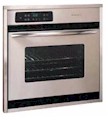How to Buy a Stove
In choosing a new oven or range, the two most important choices will be driven by the size and space for the stove and by the fuels available. For all types of stoves, there is a broad range of prices.
First a few basic definitions ...
- Cook-tops - cooking surface with burners used for boiling, sautéing, frying, etc.
- Ovens - enclosed cooking areas, used for baking, broiling, etc.
- Stoves, Ranges - units with both a cook-top and oven. These may be free standing or slide-in.
 |
 |
 |
| Shown above, a Viking cook-top (left), a Figidaire oven (center), and a GE stove (right) | ||
Types of Cooking Appliances
When buying a new cooking appliance, you have the choice of buying one combined unit, or a separate cook-top and oven. Separate units can provide flexibility such as putting the cook-top in an island and a wall oven for convenient height, but usually will need to be considered when the kitchen is designed. Often, size and space will be most important consideration when the new oven must fit in the space of the oven it is replacing.
Cook-tops:
- Gas cook-tops provide a visible flame allowing instant heat, quick response and accurate control at a lower operating cost than electric cook-tops. Cast iron burners can be lifted for easy cleaning.
- Electric cook-tops heat up faster, even than the most high-powered gas cook-tops. Electric cook-tops are better than gas at maintaining a low heat, allowing simmering without scorching the food. The electric coils are cheap and easy to replace.
Although there are pros and cons for each, personal preference plays a large part in which type of stove cooks actually like to use. However, it is usually easiest when replacing an old unit to use the same type of fuel -- electric ranges typically require special wiring and gas stove require access to a gas line.
There are more options for electric cook-tops.
- Ceramic cook-tops have the electric coils under translucent glass. There is a red glow on the burner which cycles on and off to maintain an even heat. Although it does not adjust as quickly as a traditional coil element, ceramic cook-tops are completely flat allowing easy clean ups. However, the spills must be cleaned quickly. Only heavy-gauge flat medal pans matching the size of the burners can be used. The ceramic top can be scarred by pans being scraped along the surface and is expensive to replace unlike drip-pans or electric coils.
- Induction cook-tops use electro-magnetic energy. The burner heats up only when a pan is present, meaning that the burner will be cool to the touch and won’t burn you.
Ovens:
- Electric ovens offer more even heating than gas and also have more options.
- Self-cleaning ovens heat up to intensely high temperatures, turning spills in the oven into a fine powder that can be wiped away. The oven securely latches during the cleaning, which can take hours.
- Convection ovens have an additional heating element and a fan that circulates heated air through the oven, distributing the heat more evenly and cutting cooking times up to 25% while lowering the energy use. Convection ovens brown food more evenly, so are good for roasting and baking. These ovens tend to be less deep than conventional ovens. Most convection ovens have the option of turning the convection off, leaving you with a normal oven.
- Speed ovens combine conventional, microwave and convection to drastically cut cooking times.
- Gas ovens can offer
- Infra-red broilers use a ceramic tile to intensify the heat and distribute the heat from the broiler flame.
Whatever type of fuel you chose, the cook-tops will require ventilation to take away smoke, odors and exhaust from the gas appliances. Where possible, vent the fumes to the outdoors. Non-vented hoods act more as grease-catchers that need to be cleaned periodically. Ventilation can be provided by fans (downdraft ventilations) or hoods (updraft), either vented to the outdoors or not.
It is important to consider safety factors, especially in households with children. Wall ovens are eye level and out of reach of smaller children. Consider whether the oven racks are strong enough to hold heavy roasts without tipping. Ceramic cook-tops have lights indicating which burners are still hot, and induction cook-tops have cool burners. Knobs should be easily accessible even when large pans are on the cook- top.
Other factors to consider:
- Number, style and size of burners – including ultra-high heat burners, griddle tops, grills and wok rings
- Double ovens
- Warming drawers
- Style, including chrome or stainless steel trim and construction
- Beefy knobs
- Clocks and timers
- Storage drawers below the ovens
- Delayed start
Written by
Jamie Johnson - Johnson & Hodges
